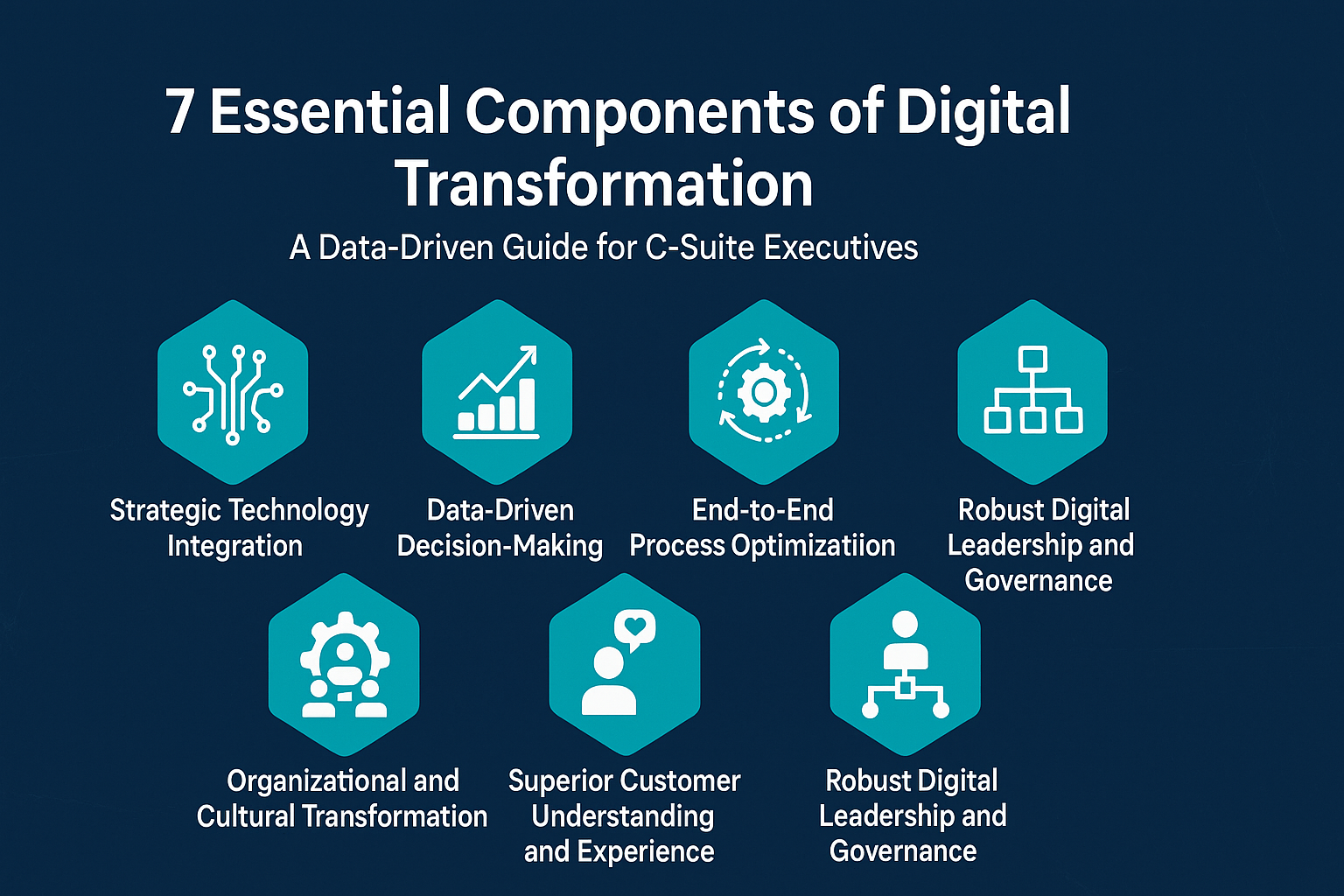In today’s dynamic and digitally driven market, achieving successful digital transformation remains a significant challenge. According to Harvard Business Review, an alarming 70% of digital transformation initiatives fail to realize their intended outcomes. Contrastingly, the 30% of successful transformations share several data-backed characteristics. This comprehensive guide, combining insights from Harvard Business Review and MIT Sloan Management Review, presents a data-rich framework tailored for C-suite executives aiming to be part of the successful minority.
1. Strategic Technology Integration
Investment alone in technology is not enough. Research indicates that organizations strategically aligning technology with clear business objectives are 50% more likely to outperform their competitors. Leading companies emphasize targeted implementation of AI, cloud solutions, and IoT, which Gartner predicts will grow global revenues by $3.9 trillion by 2025.
2. Data-Driven Decision-Making
Data is foundational for transformational success. McKinsey notes that businesses leveraging advanced data analytics experience an average profitability increase of 23%. Organizations adopting real-time analytics and predictive insights consistently outperform their peers by nearly 10% in revenue growth and cost-efficiency.
3. End-to-End Process Optimization
Successful digital transformations are marked by significant process improvements. Bain & Company’s analysis reveals organizations that streamline and digitize end-to-end processes achieve up to 20% higher productivity. Process optimization significantly enhances agility, efficiency, and customer satisfaction.
4. Organizational and Cultural Transformation
Culture significantly affects transformation outcomes. According to Deloitte, organizations with strong digital cultures experience a 25% faster speed-to-market for innovations and a 15% higher market valuation. C-suite leaders must proactively foster a culture emphasizing innovation, agility, and continuous learning.
5. Superior Customer Understanding and Experience
Deep customer insights directly influence customer experience and retention. MIT Sloan research shows that digitally advanced companies leveraging analytics improve customer retention by 17% and increase satisfaction scores by up to 32%. Executives must prioritize customer insights to maximize engagement and loyalty.
6. Business Model Innovation
Digital business model innovation significantly impacts organizational performance. Companies actively embracing digital business model transformations report revenue increases of between 15-20%. Accenture highlights that digitally-driven business models are twice as likely to achieve long-term sustainable growth.
7. Robust Digital Leadership and Governance
Effective digital leadership significantly boosts transformation success. MIT Sloan reports a 23% higher likelihood of exceeding financial and operational performance targets among organizations with strong digital governance structures. Leadership visibility and commitment are critical in driving strategic alignment and organizational buy-in.
Actionable Steps for Executives
To operationalize these insights, C-suite executives should:
- Perform Digital Readiness Assessments: Evaluate current digital maturity against clear performance benchmarks.
- Clearly Articulate Digital Vision: Communicate transformation objectives consistently across the organization to drive alignment and buy-in.
- Strategically Allocate Resources: Invest in technologies and skills that directly impact strategic business goals.
- Adopt Agile Methodologies: Implement agile processes to rapidly prototype, test, scale, and adapt digital initiatives effectively.
- Leverage Real-Time Analytics: Continuously track progress using advanced analytics to make timely adjustments and ensure successful outcomes.
Conclusion: A Data-Driven Path to Digital Excellence
Digital transformation, far beyond simple technological integration, demands a strategic, data-driven approach. C-suite executives equipped with this comprehensive, statistically validated framework are well-positioned to navigate complexities, achieve measurable performance gains, and secure lasting competitive advantages in a rapidly digitizing business environment. Embracing these seven essential components ensures that executive leadership drives meaningful transformation, positioning organizations at the forefront of digital innovation.
The article has been created analyzing the following publications as reference findings:
- The Essential Components of Digital Transformation — Tomas Chamorro‐Premuzic, Harvard Business Review, November 2021
- The Nine Elements of Digital Transformation — George Westerman, Didier Bonnet, and Andrew McAfee, MIT Sloan Management Review, January 2014
About Catallyst Insights
Catallyst Insights is your essential executive briefing, delivering data-backed analysis and actionable strategies on digital transformation, AI integration, and leadership excellence. Each issue equips C-suite leaders with the insights they need to drive innovation, optimize performance, and stay ahead in today’s fast-moving digital landscape. We’re proud to bring you the latest findings from global research—because it’s our obligation to help you remain ahead of the curve.

